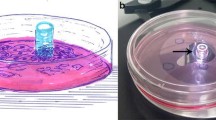Summary
The viability of the placental villi in organ culture was investigated both from the morphological and functional points of view. Morphological viability was judged on the appearance of the villi with special emphasis on the trophoblastic cells and the morphological integrity of the placental villi could be maintained for at least 96 h in organ culture. Functional viability was judged by analyses of Δ5-3β-hydroxysteroid dehydrogenase; Δ5,4-isomerase (3β-HSD) activity with14C-pregnenolone as the substrate and by the suppressive effect of the cultivated villi on the secretion of plasminogen activator (PA) obtained from mouse peritoneal macrophages stimulated by OK-432. It was found that the 3β-HSD activity and suppressive effect on PA secretion could be preserved for at least 120 h in organ culture.
Similar content being viewed by others
References
Balls M, Monnickendam MA (1976) Organ culture in biochemical research. Cambridge University Press, Cambridge, England, p 1
Chen JT, Nakabayashi M, Satoh K, Mizuno M, Sakamoto S (1983) A new assay method for inducer of plasminogen activator (IPA). Blood Vessels (in press)
Chung HK, McLimans WF, Horoszewicz J, Hreshchyshyn MM (1966) In vitro studies of human trophoblast. Am J Obstet Gynecol 104: 945–952
Cotte C, Easty GC, Neville AM, Monoghan P (1980) Preparation of highly purified cytotrophoblast from human placenta with subsequent modulation to form syncytiotrophoblast in monolayer culture. In Vitro 16: 639–646
Dreskin RB, Spicer SS, Greene WB (1970) Ultrastructural localization of chorionic gonadotropin in human term placenta. J Histochem Cytochem 18: 862–843
Fox H, Karhongor FN (1970) Immunofluorescent localization of chorionic gonadotropin in the placenta and in tissue cultures of human trophoblast. J Pathol 101: 277–282
Gespard UJ, Hustin J, Reuter AM, Lambotte R, Franchimont P (1980) Immunofluorescent localization of placental lactogen, chorionic gonadotropin and its alpha and beta subunits in organ culture of human placenta. Placenta 1: 135–144
Huo LT, Swanson-Beck J (1967) Persistence of growth hormone like antigen in organ culture of human placentas. Experientia 23: 846–848
Huo LT, Ewen SW, Swanson-Beck J (1968) Histological, metabolic and histochemical studies on normal placenta in organ culture. Br J Exp Pathol 49: 648–657
Huot RI, Froidart JM, Stromberg K (1979) Effects of culture conditons on the synthesis of human chorionic gonaodotropin by placental organ culture. In Vitro 15: 497–502
Hustin J, Gespard U (1977) Comparison of histological changes seen in placental tissue cultured and in placentae obtained after fetal death. Br J Obstet Gynaecol 84: 210–215
Ikonicoff de L, Cedard L (1973) Localization of human chorionic gonadotropic and somatomammotropic hormones by the peroxidase immunohistoenzymologic method in villi and amniotic epithelium of the human placentas (from six weeks to term). Am J Obstet Gynecol 116: 1124–1132
Kinoshita M, Tominaga T, Nishimura T (1976) Observation of rapid migration of trophoblastic cells from human chorionic villi cultured on fixed gelatin film. Acta Obsted Gynaecol Jpn 23: 133–139
Levintow L, Eagle H (1961) Biochemistry of cultured mammalian cells. Ann Rev Biochem 30: 605–640
MacLennan AH, Sharp F, Shaw-Dunn J (1972) The ultrastructure of human trophoblast in spontaneous and induced hypoxia using a system of organ culture. J Obstet Gynaecol Br Commonw 79: 113–121
Midgley AR Jr, Pierce GB Jr (1962) Immunohistochemical localization of human chorionic gonadotropin. J Exp Med 115: 289–297
Roy PW, Ryan GE, Bransome ED (1974) Primary culture and maintenance of steroid-scereting human placental monolayer. In Vitro 12: 115–120
Stoner GD, Harris CC, Autrup H, Trump BF, Kingsbury EW, Meyers GA (1978) Explant culture of human peripheral lung. I. Metabolism of benzo(a)pyrene. Lab Invest 38: 685–692
Stromberg K, Azizkham JC, Speeg KV (1978) Isolation of functional human trophoblast cells and their partial characterization in primary cell culture. In Vitro 14: 631–638
Tao TW (1962) Tissue culture studies of nomal immature human placentas with special reference to morphogenesis, endocrine function and reaggregation. Ph. D. Thesus, Harvard University
Tao TW, Hertig AT (1961) Studies on morphology and hormone secretion of human immature placentas maintained in organ and tissue cultures. Exp Med Sect 15: 557
Tao TW, Hertig AT (1965) Viability and differentiation of human trophoblast in organ culture. Am J Anat 116: 315–328
Taylor PV, Hancock KW (1973) Viability of human trophoblast in vitro. J Obsted Gynaecol Br Commonw 80: 834–838
Thiede HA (1960) Studies of the human trophoblast in tissue culture. I. Cultural methods and histochemical staining. Am J Obstet Gynecol 79: 636–647
Author information
Authors and Affiliations
Rights and permissions
About this article
Cite this article
Ogino, M., Satoh, M., Kinoshita, K. et al. Viability of the human placental villi in organ culture. Arch. Gynecol. 234, 235–246 (1984). https://doi.org/10.1007/BF02113808
Received:
Accepted:
Issue Date:
DOI: https://doi.org/10.1007/BF02113808




